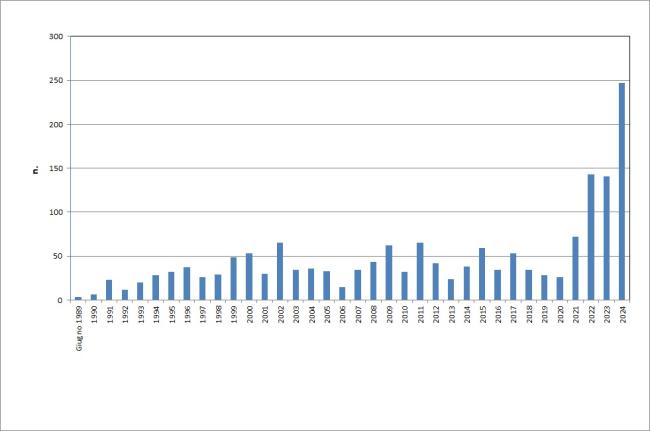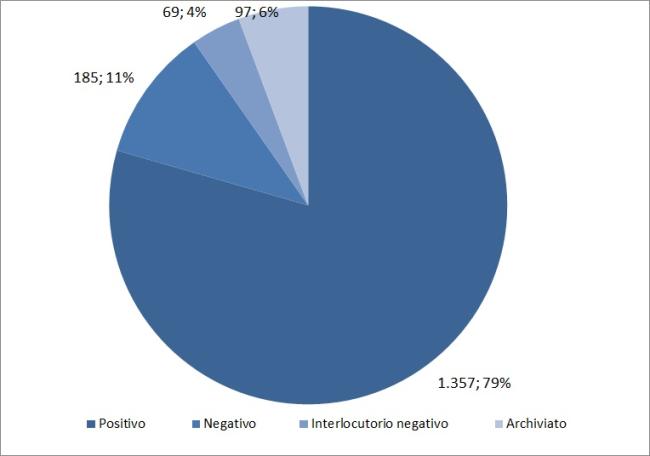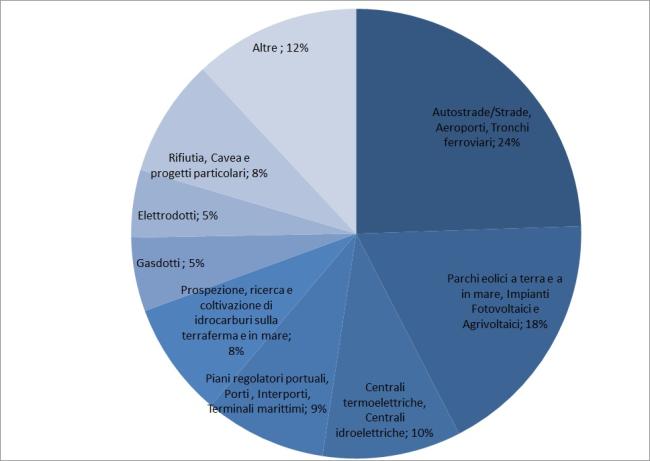Panel 1
Anna Cacciuni, Caterina D'Anna
The indicator illustrates the yearly trend in the number of projects under national jurisdiction subject to Environmental Impact Assessment (EIA), the distribution of the outcomes of environmental compatibility decisions over time, and their classification by project type. It reflects the response of the central public administration in environmental decision-making processes. In 2024, out of 247 assessed projects, 221 were issued positive EIA decisions with environmental conditions, and 26 received negative decisions.
Environmental Impact Assessment (EIA) is a process regulated by Title III of Part II of Legislative Decree 152/2006 and subsequent amendments. It involves the preparation and submission of the Environmental Impact Study by the project proponent, public consultations, the evaluation of the study and any additional information, and the final EIA decision regarding the environmental impacts of the project. This decision is then integrated into the final approval or authorization of the project.
The technical assessment is carried out by:
The Technical Commission for Environmental Impact Assessment – EIA and SEA (CTVA), established by Ministerial Decree No. 342 of 13 December 2017, for general projects and plans.
The PNIEC-PNRR Commission, established by Ministerial Decree No. 361 of 2 September 2021, for projects funded under the National Recovery and Resilience Plan (PNRR) and the National Integrated Energy and Climate Plan (PNIEC).
These bodies issue a reasoned opinion that forms the basis for the final EIA decree issued by the Ministry of the Environment and Energy Security (MASE), in agreement with the Ministry of Culture (MiC).
An EIA decree is a reasoned, binding, and mandatory decision expressing the competent authority’s conclusion on the significant environmental effects of a project, based on technical evaluation, public consultation, and any cross-border consultation.
Illustrate the trend over the years in the number of works subject to EIA, in accordance with the provisions of current regulations, the distribution of the results of environmental compatibility rulings and their distribution according to the different types of works.
Therefore, the main purpose of the indicator is to provide information on the response of the central public administration regarding the decision-making processes related to environmental assessments.
Directive 85/337/EEC of 27 June 1985 Assessment of the effects of certain public and private projects on the environment
Directive 97/11/EC of 3 March 1997 amending Directive 85/337/EEC - Assessment of the effects of certain public and private projects on the environment
Directive 2011/92/EU of 13 December 2011 - Assessment of the effects of certain public and private projects on the environment
Directive 2014/52/EU of the European Parliament and of the Council of 16 April 2014 amending Directive 2011/92/EU on the assessment of the effects of certain public and private projects on the environment
Legislative Decree 152/2006 and subsequent amendments
Legislative Decree no. 104 of 2017 DL 34/2020 converted into Law 77/2020
DL 76/2020 converted into Law 120/2020
DL 77/2021 Simplification Decree converted into Law no. 108 of 29 July 2021
ANNEX I-bis part II of Legislative Decree 152/2006 as amended, pursuant to Article 35 of Decree-Law No. 77 of 2021 (Annex introduced by Article 18, paragraph 1, letter b) of Decree-Law No. 77 of 2021)
DL 92/2021 Urgent measures for the strengthening of the Ministry of Ecological Transition and in the field of sport.
Law No. 25 of 2022
Law No. 91 of 2022
Law No. 6 of 2023
Decree-Law No. 13 of 2023
Panel 2
The indicator does not include works subject to a regional EIA procedure.
Development of the same indicator at regional level.
Data quality assessment
Ministry of the Environment and Energy Security (MASE)
Ministry of Culture (MiC)
The EIA measures can be found on the MASE portal for environmental assessments on which all the measures are published https://va.mite.gov.it/it-IT/Procedure/Provvedimenti
National
June 1989- 2024
Indicator assessment
The individual EIA measures under state competence were collected and analyzed. Starting from the measures published on the MASE website, data were processed relating to the total number of measures, positive, negative, negative and archived for each year. The measures extending the validity of the measures already issued have not been counted.
The types of projects subject to nationally regulated EIAs have changed over the years in response
to European Directives and national legislation. In 2024, out of 247 projects examined, 221 positive
EIA decisions with environmental conditions were issued, along with 26 negative ones (Table 1).
From June 1989 to 2024, a total of 1,708 projects were examined, resulting in 1,357 positive EIA
decisions, 185 negative, 69 conditionally negative, and 97 archived decisions (Table 1 and Figure
1). The trend can be considered positive, as the average number of annual decisions in the last ten
years (84) exceeds the 36-year average (47), indicating greater attention to the country’s sustainable
and economic development.
Data
Table 1: Total number of state-level EIA decisions with positive, negative, and conditionally negative outcomes
ISPRA processing on MASE data
a Occurs when there is a substantial lack of information in the submitted documentation such that it is not possible to issue a judgment on the project's compatibility. This type existed until the enactment of Legislative Decree 128/2010 amending Legislative Decree 152/2006.
b Archived decision: when the proponent does not submit the additional documentation within the deadline set in the communication from the EIA Directorate of MASE. After this deadline or if the documentation remains incomplete upon verification, the application is archived.
Over the years, extension decisions for the validity of already issued decisions have been issued but were not counted.
Table 2: Number of positive decisions by project type coded by Legislative Decree 152/2006 and subsequent amendments
ISPRA processing based on MASE data
Figura 1: Numero totale di provvedimenti VIA di competenza statale
Elaborazione ISPRA su dati MASE
Figura 2: Ripartizione per esito dei provvedimenti VIA di competenza statale
Elaborazione ISPRA su dati MASE
Figura 3: Ripartizione dei provvedimenti di VIA di competenza statale per tipologia d'opera codificate dal D.Lgs 152/2006 e s.m.i.
Elaborazione ISPRA su dati MASE
a Non più presenti tra le tipologie di opere da assoggettare a VIA nazionale in quanto trasferite tra quelle da assoggettare a VIA regionale. Le opere possono essere assoggettate a VIA nazionale su richiesta della regione.
Per la tipologia d'opera Rifiuti nell'anno 2013 risulta un'opera soggetta a procedura di VIA nazionale su richiesta della regione
Figure 3: Breakdown of EIA measures under state jurisdiction by type of work codified by Legislative Decree 152/2006 as amended.
ISPRA processing on MASE data
* No longer present among the types of works to be subject to national EIA as they have been transferred among those to be subject to regional EIA. The works may be subject to a national EIA at the request of the region.
For the type of work Waste in 2013 there was a work subject to a national EIA procedure at the request of the region



Over the 36-year period considered, approximately 79% of submitted projects concluded with a positive EIA decision (Figure 2). Among the positive decisions (Figure 3), large transportation infrastructures stand out: highways, roads, airports, railway sections, and ports account for about a quarter of all issued authorizations. Next are renewable energy sources—onshore and offshore wind farms, photovoltaic and agrivoltaic plants—which represent nearly one-fifth of the total, highlighting a growing interest in decarbonization.